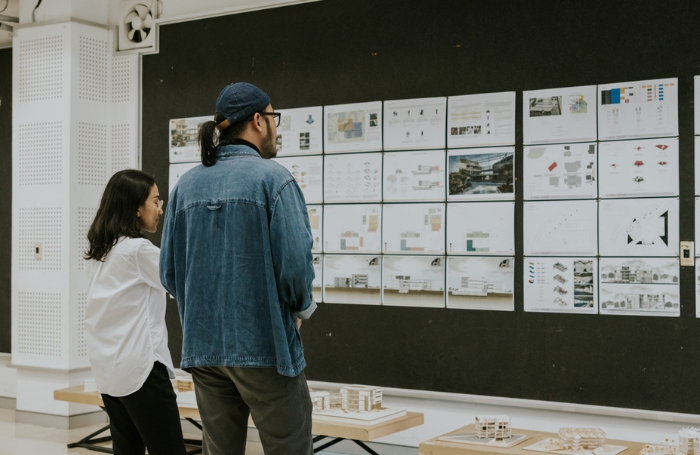Once again the graduate show season is upon us, when students (of all ages) get their chance to showcase their talents and network with practitioners. These shows are the culmination of months, if not years, of hard graft and long hours. However, aside from the hard work, at their core graduate shows are celebrations of emerging talent and fresh thinking.
Graduate shows are an industry staple for good reason, and not just for students – for architects it’s important to attend local shows for a number of reasons. Not only are they emblematic of architecture as a whole (showing innovation, creativity, and the ability to problem-solve), but they’re a chance for architects to support the new generation, boost their practice’s profile, and be inspired by new ideas.

1. Recruitment: architects can spot outstanding talent
Degree shows give practices a chance to discover outstanding candidates for employment in a very different setting from the usual recruitment scenario. A good student presentation at a show allows an employer to assess many different aspects of a student’s abilities very quickly: well-thought through and original designs, solid and perhaps innovative presentation skills, and their ability to hold a good conversation and clearly articulate their ideas.
“Many practices who are deep in commercial projects benefit from the inspiration of student work, with their outside-the-box thinking and alternative presentation styles,” says Joseph Silva, Principal Architect at Stephen George and co-Chair of the Leicestershire Society of Architects.
“As an employer, when I attend these shows, not only am I looking at potential architectural assistants to hire, I am also looking at the new software that students are using, and seeing how we could implement this into our workflows as a practice to stay on top of industry changes.”
2. Networking: the chance for architects to meet peers and share ideas
Graduate shows are a great way for students to get to know local practices, but they’re not just for students - they’re also a great way for architects to connect with studio tutors and researchers and to network with fellow architects. In the regions particularly, graduate shows are often regarded as some of the most rewarding networking events of the year. When it comes to networking, opening night is often best and attracts the largest groups of attendees, especially from the profession.
There may also be opportunities to discuss collaborations and teaching opportunities with the school, or short-term work experience or placements for students.
3. Discover freelancers with leading-edge software skills
Many graduates will have developed specialist IT or software skills they could bring to a practice as freelancers or through short-term collaborative placements. They may have advanced skills in emerging areas such as visualisation, AI-enabled coding, digital fabrication or parametric design that could be outside of a practice’s experience or skillset. In this context, the student could well become the teacher.
Some graduates may even have explored emerging management systems such as AI-assisted workflows, or the creation of sophisticated interactive experiences using game engines like Unity or Unreal Engine.

4. Engagement: architects can build a profile within their local community
Degree shows frequently feature projects that are presented as solutions to real-world local sites, often with the kind of freedom only a student works with. These projects may also address larger problems at regional or city level with fresh thinking on housing, infrastructure or perhaps heritage.
“We continue to make great new connections at end of year shows, for recruitment and also to foster greater community involvement,” says Leanora Simmonite, Associate at Bond Bryan and President of the Sheffield Society of Architects.
5. Keeping up with academic trends in architecture
Curricula constantly evolve in schools of architecture. Some schools will have strengths in a more theoretical or research-based approach, others will put more emphasis on technical detail. But whichever way a practice’s local or regional schools lean, their students are likely to be pushing the boundaries when it comes to concepts, approaches, and processes. These new approaches are being applied by students on everything from routine project assignments to the biggest issues of the day, such as sustainability, digital fabrication or AI in design.
Ben Pipkin, Design Lead at Leeds-based Cuniff Design, says he is always eager to attend graduate shows to see how students are addressing emerging challenges: “I always look forward to attending end of year shows. I’m continually impressed at the many creative approaches students take in tackling the big issues of the built environment. Degree shows are an important occasion in maintaining the vital connection between academia and industry.”
As the students work at the cutting edge, it’s a great opportunity for architects to explore and expose themselves to changing landscapes, technologies, and methodologies.
6. Supporting the next generation of architects
Architects should never underestimate the value students place on being able to discuss their work with local practices, to the extent that a practicing architect showing interest is seen by students as validating their efforts. Additionally, discussing their work in the context of the realities of the profession is seen as a form of mentorship.
“These events provide insight into what working in practice is really like, while boosting confidence in sharing ideas and work. Without them, I wouldn’t have built the connections that helped me secure a Part 1 job,” says Sheffield University architecture student, Eva Lily Carrasco.
“Having a relationship with a practice meant they already understood my work ethic and capabilities, giving them confidence in hiring me over someone they hadn’t met before.”
Read more about how to get hired on the spot at graduate degree shows

7. Get inspired by free-thinking students
Students’ work can be wildly creative and experimental in architectural form and their use of materials, so much so that they may not worry as much about the practical constraints that face some practices. But even so, their fresh thinking can still inspire and their visual storytelling may employ digital techniques that an architect has not encountered before.
“Attending end-of-year architecture shows provides a unique opportunity to witness fresh, innovative ideas and creative design solutions. It also fosters networking with emerging talent, while giving insights into the latest trends and techniques in architecture,” says Luke Sach, Associate in DLA Architecture’s Leeds office.
8. Boosting an architecture practice’s brand profile
Just getting out to a graduate show is a good way not only to network and enjoy exposure to new trends and ideas, but it’s also a great way to boost a practice’s brand profile locally.
By being at a show, chatting to students, tutors, and peers can almost instantly increase not only brand visibility but also recognition, especially in a local area.
For that extra boost, if a practice is in a position to do so, how about sponsoring a show? This would mean a practice’s name and logo appearing pride of place on show literature, around the show itself and in pre-show advertising.
9. It’s a celebration of the profession
Architects and students should never forget this last reason.
Graduate shows are also a chance for architects to celebrate architecture as an art, and perhaps reconnect with their own early passions and idealism. Many architects leave a show inspired and eager to test a new way of approaching their own projects.
In this way, end-of-year degree shows often provide a crucial spark of renewal and forward-thinking momentum.
Thanks to Leanora Simmonite, Bond Bryan and the Sheffield Society of Architects; Ben Pipkin, Cuniff Design; Eva-Lily Carrasco; Luke Sach, DLA Architecture.
Text by Neal Morris. This is a Professional Feature edited by the RIBA Practice team. Send us your feedback and ideas.
RIBA Core Curriculum topic: Business, clients, and services.
As part of the flexible RIBA CPD programme, professional features count as microlearning. See further information on the updated RIBA CPD core curriculum and on fulfilling your CPD requirements as a RIBA Chartered Member.









